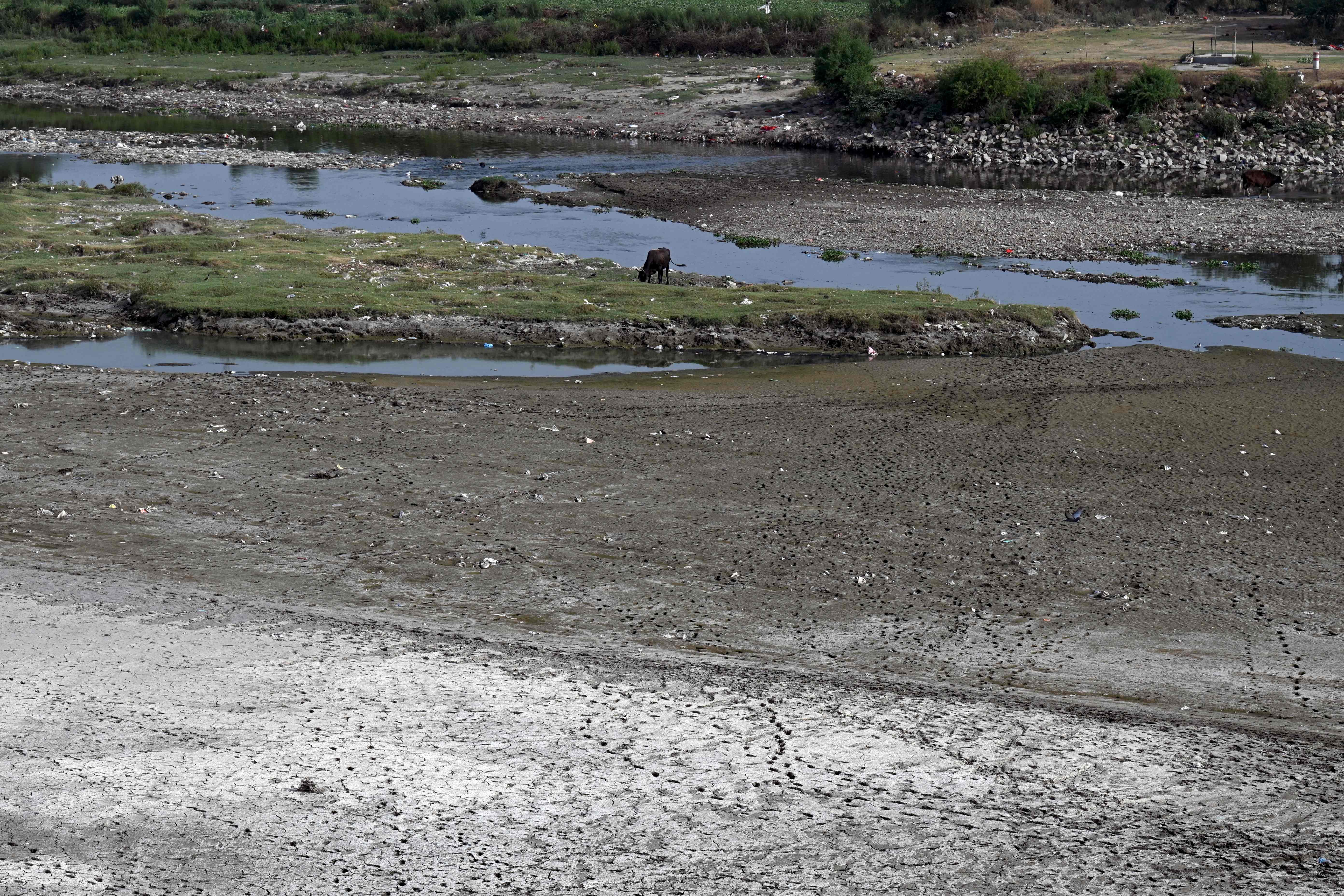India and Pakistan heatwave 30 times more likely because of climate change
Sign up now: Get ST's newsletters delivered to your inbox

A villager walks through the cracked bottom of a dried-out pond on a hot summer day in Pali district, India, on May 11, 2022.
PHOTO: AFP
Follow topic:
NEW DELHI - Heatwaves such as the brutally long and early one over parts of India and Pakistan this year, which largely persists and has so far claimed at least 90 lives and resulted in crippling power shortages as well as reduced agricultural yields, are about 30 times more likely because of human-induced climate change.
This was the finding of a study released on Monday (May 23) by an international team of 29 climate scientists under the World Weather Attribution (WWA) group.
Their analysis showed that an event such as the current long-running heatwave is still rare, with the probability of one occurring once every 100 years, but also revealed that human-induced climate change since the pre-industrial era has made it about 30 times more likely, implying it would have been "extraordinarily rare", a one in 3,000 years event, without the impact of climate change.
To arrive at an understanding of how climate change would impact the long-running spell of high temperatures in India and Pakistan, the scientists used temperature data from the region and computer simulations to compare the climate as it is today, factoring in a 1.2 deg C global warming since the late 1800s, with the climate of the past.
Large parts of India and Pakistan have been experiencing an unusually early and long-running heatwave this year, which has been exacerbated by the lack of pre-monsoon rainfall. It began as early as March, which was the hottest ever since India began keeping temperature records in 1901, and intensified in April.
Heatwaves occur mostly from April to June, with their severity and frequency peaking in May. But usual peak temperatures of more than 45 deg C were attained in many parts of India in April this year, which was the third-hottest in 122 years.
According to a report in IndiaSpend, a portal that focuses on data journalism, April 2022 had the highest number of weather stations in the country, 25, recording more than 45 deg C temperatures in the last 12 years.
Temperatures have also soared to record-levels over Pakistan; on May 14, Jacobabad was one of the hottest cities on earth at 51 deg C.
Pakistan's Minister for Climate Change Senator Sherry Rehman has described this year as a "spring-less" year for her country, with reports of many individuals there being forced to drink contaminated water because of a water shortage brought about by the prolonged dry period.
India's capital Delhi is also experiencing a water shortage with the Yamuna river "almost dry".
Experts fear extreme heatwaves will become more frequent and intense, in the light of rising global temperatures but torpid moves to cut emissions, forcing millions in this heavily populated region of South Asia to readjust how they work and live.
Professor Krishna AchutaRao from the Centre for Atmospheric Sciences at the Indian Institute of Technology Delhi told a WWA media briefing on Monday that a 2 deg C rise in temperature would make an event such as the 2022 heatwave "anywhere between two to 20 times more probable".
"It would also be between half a degree to 1½ degrees warmer compared to what we have seen in this 2022 event," added Prof AchutaRao, who was involved in the study.
This analysis follows the release of another report last week by the United Kingdom's national weather service that found the record-breaking heatwaves in India and Pakistan have been made 100 times more likely by the climate crisis.

Those associated with the WWA study said their findings were "probably on the conservative side" and linked their lower estimates to various factors, including the fact that they studied a different region in India and Pakistan compared with the Met Office, as well as multiple climate models used that have different ways of translating emissions into temperatures.
"The real result is probably somewhere between ours and the Met Office result, I would say, for how much climate change increased this event," said Dr Friederike Otto, a senior lecturer in Climate Science at Imperial College London and WWA's co-lead
Meanwhile, parts of north-east India and adjoining Bangladesh continue to reel under intense rainfall and crippling floods that have left more than 50 dead, reinforcing weather extremes associated with climate change.

Dr Roxy Mathew Koll, a climate scientist with the Indian Institute of Tropical Meteorology in Pune, told The Straits Times that besides a steady rise in heatwaves over India and Pakistan, episodes of extreme rain that cause flooding in India have tripled during the last few decades along with Arabian Sea cyclones that have also increased by more than 50 per cent.
"We are already seeing a 1.1 deg C rise in mean global temperatures and its impact," he said, adding that he is especially concerned by an insufficient global commitment towards reduction in emissions to keep these temperatures from shooting up further.
At the current rate of progression, the earth's long-term average temperature is expected to increase by 2 deg C by 2060. "Though we can simulate the way weather systems behave in climate models, as a climate scientist, it is still difficult for me to even imagine the impacts when global temperatures get doubled," Dr Koll said.
"The pace of warming is now so accelerated that we need urgent action towards mitigation at global levels. Our climate action plans should be aligned to this near-future that we are living through. Unfortunately, they are not."

